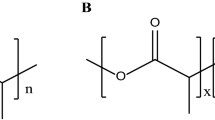Abstract
Purpose. The major objectives of this study were to 1) develop a new mathematical model describing all phases of drug release from bioerodible microparticles; 2) evaluate the validity of the theory with experimental data; and 3) use the model to elucidate the release mechanisms in poly(lactide-co-glycolide acid)-based microspheres.
Methods. 5-Fluorouracil-loaded microparticles were prepared with an oil-in-water solvent extraction technique and characterized in vitro. Monte Carlo simulations and sets of partial differential equations were used to describe the occurring chemical reactions and physical mass transport phenomena during drug release.
Results. The new mathematical model considers drug dissolution, diffusion with nonconstant diffusivities and moving boundary conditions, polymer degradation/erosion, time-dependent system porosities, and the three-dimensional geometry of the devices. In contrast with previous theories, this model is able to describe the observed drug release kinetics accurately over the entire period of time, including 1) initial “burst” effects; 2) subsequent, approximately zero-order drug release phases; and 3) second rapid drug release phases. Important information, such as the evolution of the drug concentration profiles within the microparticles, can be calculated.
Conclusions. A new, mechanistic mathematical model was developed that allows further insight into the release mechanisms in bioerodible microparticles.
Similar content being viewed by others
REFERENCES
L. T. Fan and S. K. Singh. Controlled Release: A Quantitative Treatment, Springer-Verlag, Berlin, 1989.
J. Siepmann and A. Göpferich. Mathematical modeling of bioerodible, polymeric drug delivery systems. Adv. Drug Deliv. Rev. 48:229–247 (2001).
J. Siepmann and N. A. Peppas. Modeling of drug release from delivery systems based on hydroxypropyl methylcellulose (HPMC). Adv. Drug Deliv. Rev. 48:139–157 (2001).
M. Vert, J. Feijen, A. Albertsson, G. Scott, and E. Chiellini. Biodegradable Polymers and Plastics, Redwood Press, Melksham, 1992.
A. Göpferich. Polymer degradation and erosion: mechanisms and applications. Eur. J. Pharm. Biopharm. 42:1–11 (1996).
J. Siepmann, A. Streubel, and N. A. Peppas. Understanding and predicting drug delivery from hydrophilic matrix tablets using the “sequential layer” model. Pharm. Res. 19:306–314 (2002).
J. Siepmann, H. Kranz, N. A. Peppas, and R. Bodmeier. Calculation of the required size and shape of hydroxypropyl methylcellulose matrices to achieve desired drug release profiles. Int. J. Pharm. 201:151–164 (2000).
A. Shenderova, T. G. Burke, and S. P. Schwendeman. The acidic microclimate in poly(lactide-co-glycolide) microspheres stabilizes camptothecins. Pharm. Res. 16:241–248 (1999).
G. Spenlehauer, M. Vert, J. P. Benoit, and A. Boddaert. In vitro and in vivo degradation of poly(D,L lactide/glycolide) type microspheres made by solvent evaporation method. Biomaterials 10:557–563 (1989).
M. Dunne, O. I. Corrigan, and Z. Ramtoola. Influence of particle size and dissolution conditions on the degradation properties of polylactide-co-glycolide particles. Biomaterials 21:1659–1668 (2000).
J. M. Anderson and M. S. Shive. Biodegradation and biocompatibility of PLA and PLGA microspheres. Adv. Drug Del. Rev. 28:5–24 (1997).
P. Sansdrap and A. J. Moes. In vitro evaluation of the hydrolytic degradation of dispersed and aggregated poly(DL-lactide-coglycolide) microspheres. J. Control. Release 43:47–58 (1997).
H. B. Ravivarapu, K. Burton, and P. P. DeLuca. Polymer and microsphere blending to alter the release of a peptide from PLGA microspheres. Eur. J. Pharm. Biopharm. 50:263–270 (2000).
H. B. Hopfenberg. Controlled release from erodible slabs, cylinders, and spheres. In D. R. Paul and F. W. Harris (eds.), Controlled Release Polymeric Formulations, ACS Symp. Ser. No. 33, American Chemical Society, Washington, 1976 pp. 26–32.
D. O. Cooney. Effect of geometry on the dissolution of pharmaceutical tablets and other solids: Surface detachment kinetics controlling. AIChE J. 18:446–449 (1972).
J. Heller and R. W. Baker. Theory and practice of controlled drug delivery from bioerodible polymers. In R. W. Baker (ed.), Controlled Release of Bioactive Materials, Academic Press, New York, 1980 pp. 1–18.
P. I. Lee. Diffusional release of a solute from a polymeric matrix-approximate analytical solutions. J. Membr. Sci. 7:255–275 (1980).
K. Zygourakis. Discrete simulations and bioerodible controlled release systems. Polym. Prep. ACS 30:456–457 (1989).
K. Zygourakis. Development and temporal evolution of erosion fronts in bioerodible controlled release devices. Chem. Eng. Sci. 45:2359–2366 (1990).
A. Göpferich. Mechanisms of polymer degradation and erosion. Biomaterials 17:103–114 (1996).
A. Göpferich. Bioerodible implants with programmable drug release. J. Control. Release 44:271–281 (1997).
A. Göpferich. Erosion of composite polymer matrices. Biomaterials 18:397–403 (1997).
A. Kalampokis, P. Argyrakis, and P. Macheras. Heterogeneous tube model for the study of small intestinal transit flow. Pharm. Res. 16:87–91 (1999).
A. Kalampokis, P. Argyrakis, and P. Macheras. A heterogeneous tube model of intestinal drug absorption based on probabilistic concepts. Pharm. Res. 16:1764–1769 (1999).
A. Bunde, S. Havlin, R. Nossal, H. E. Stanley, and G. H. Weiss. On controlled diffusion-limited drug release from a leaky matrix. J. Chem. Phys. 83:5909–5913 (1985).
A. Charlier, B. Leclerc, and G. Couarraze. Release of mifepristone from biodegradable matrices: Experimental and theoretical evaluations. Int. J. Pharm. 200:115–120 (2000).
N. Faisant, J. Siepmann, and J. P. Benoit. PLGA-based microparticles: Elucidation of mechanisms and a new, simple mathematical model quantifying drug release. Eur. J. Pharm. Sci. 15: 355–366 (2002).
N. Faisant, J. Siepmann, P. Oury, V. Laffineur, E. Bruna, J. Haffner, and J. P. Benoit. The effect of gamma-irradiation on drug release from bioerodible microparticles: A quantitative treatment. Int. J. Pharm. 242:281–284 (2002).
J. Crank. The Mathematics of Diffusion, 2nd ed., Clarendon Press, Oxford, 1975.
J. Wang, B. M. Wang, and S. P. Schwendeman. Characterization of the initial burst drug release from poly(D,L-lactide-coglycolide) microspheres II: Alterations in surface permeability implicated in cessation of burst release. Proceedings AAPS Annual Meeting, Indianapolis, Indiana (2000).
Author information
Authors and Affiliations
Corresponding author
Rights and permissions
About this article
Cite this article
Siepmann, J., Faisant, N. & Benoit, JP. A New Mathematical Model Quantifying Drug Release from Bioerodible Microparticles Using Monte Carlo Simulations. Pharm Res 19, 1885–1893 (2002). https://doi.org/10.1023/A:1021457911533
Issue Date:
DOI: https://doi.org/10.1023/A:1021457911533




